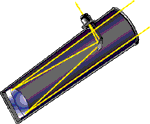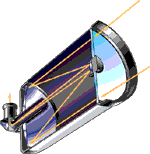 |
Courtesy of |
 |
Courtesy of |
| Choosing your first Telescope. Answers to Commonly Asked Questions. |
| Question: Which type of Telescope should I buy: a refractor, reflector, or catadioptic? |
| Answer: Each Telescope has it's own advantages and disadvantages, which you must weigh against your own interests and needs. Refractors are fairly portable and offer the finest image quality, but they are also the priciest per inch of aperture. They excel for detailed views of the Moon and planets, but are not very well suited for deep-sky observation. Reflectors (Newtonians) boast generous light-gathering power for an economical price. They provide excellent performance on deep-sky clusters, nebulae's, and galaxies. Reflectors tend to be bulky, and require more maintenance than other telescopes. Catadioptic telescopes, such as the Cassegrains, are compact and portable, even in apertures of 8" or more. They offer good, all-around prowess and are easily adapted for astrophotography. They are not cheap, though; costs run upwards of $1,000. |
 |
 |
 |
| Refractor | Reflector (Newtonians) |
Catadioptic (Schmidt-Cassegrain) |
| Question: What will I be able to see? |
| Answer: The larger the telescope's aperture, the more you will be able to see. But even a 60mm (2.4") refractor will reveal many breathtaking sights, including the rings of Saturn, Jupiter and its four largest moons, countless rills and craters on the Moon, the ghostly Orion Nebulae, and the dazzling Double Cluster, to name a few. With bigger telescopes, you will see fainter objects and finer details. |
| Question: Isn't high power really important? |
| Answer: Surprisingly, no.
Aperture (the diameter of the main mirror or lens), not power, is what determines how much
you will be able to see. Keep in mind that the higher the magnifying power, the dimmer an
object will appear. So high power is best reserved for studying bright objects, such as
the Moon and planets. In general, the sharpest, most pleasing views are obtained at low
powers of 25x to 50x. IMPORTANT NOTE: Do not be mislead by claims of excessive power, as are commonly made for telescopes you see in department stores. That's a sure sign of an inferior product. The practical limit for any telescope is about 45x-60x per inch of aperture. For a 60mm (2.4") telescope, that's 144x. Going any higher will produce only dim or fuzzy images. Magnification is not related to quality or performance. |
| Remember: The magnification is the telescope focal length divide by the eyepiece focal length, in millimeters. |
| Question: Will I be able to do astrophotography? |
| Answer: Not every telescope is suitable for deep-sky astrophotography. It must have a very sturdy equatorial mount that is equipped with a motor drive on both axes and a drive corrector or controller. Those criteria rule out most "beginner" telescopes and altazimuth-mounted instruments such as Dobsonians. Cassegrain-type scopes are perhaps the best suited for celestial photography, given their large aperture and easy camera-adaptability. |
| Question: How does sky darkness factor in? |
| Answer: The darker the sky, the
better. But even from a moderately light-polluted site, you'll be able to enjoy nice views
of the Moon, the planets, and possibly some of the brighter deep-sky clusters and nebulas.
When sky-glow is a factor, choose a telescope of smaller aperture (4" or less")
and high focal ratio (f/8 or higher). Using a light-pollution filter helps. If you'll be observing from a dark, rural site, a telescope of any aperture and focal ratio will provide grand views. |
| We hope to have answered some of the most commonly asked questions. If you have other questions please ... |